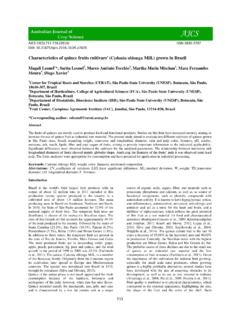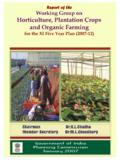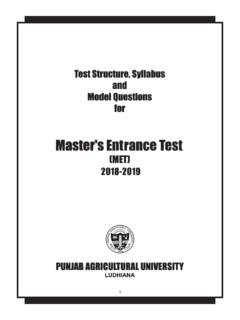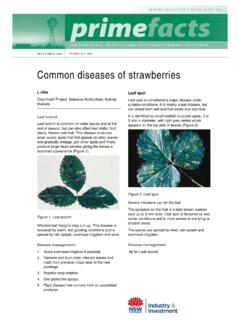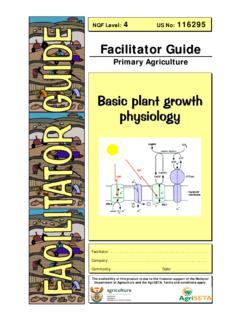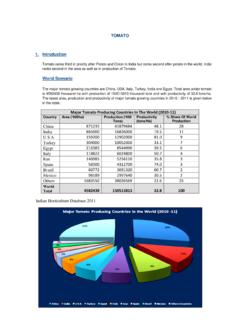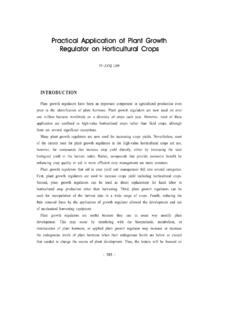Transcription of Recommended Fruit and Nut Varieties - Texas A&M AgriLife
1 HC-GFS-06-008 Harris County Cooperative Extension3033 Bear Creek Drive, Houston, Texas FACT SHEETMany types of fruits and nuts grow well in home orchards in Harris County. The first key to a successful harvest is to select Varieties best suited to our subtropical climate. One of the most important considerations in selecting an appropriate plant is its temperature requirements. Citrus trees are subtropical to tropical in nature and many may suffer severe damage or even death in freezing temperatures.
2 However, several types of citrus are sufficiently cold hardy to survive most winters in our region, particularly as mature trees, and especially in the warmer areas of the county. Planting citrus trees on the south and southeast sides of the house or in other sheltered locations will provide some protection from northwesterly cold fronts. Aside from knowing how much cold a plant can stand, it is also important to know how much cold it needs. Stone and pome Fruit trees need a period of winter rest or dormancy, when temperatures are between 32 F and 45 F for flowers and leaf buds to develop normally.
3 When enough chilling accumulates, the buds are ready to grow in response to warm temperatures. If the buds do not receive sufficient chilling temperatures during winter to completely release dormancy, trees may develop physiological symptoms such as delayed and extended bloom, delayed foliation, reduced Fruit set and reduced Fruit species and Varieties of stone and pome Fruit trees have different chilling requirements. It is important to know the chilling requirements of the Varieties you select and to select Varieties with chilling requirements most closely matched to your area of the county.
4 Thus, knowing your local chill hours is helpful for selecting the right tree. Within the Harris County area, Pasadena and the Galveston Bay area on the south side of the county receive approximately 350 450 chill hours; downtown Houston receives approximately 450 hours; Cypress and the Bear Creek area receive approximately 600 Fruit and Nut VarietiesHarris County and Vicinityby William D. Adams, County Extension Agent Horticulture, emeritusedited by Carol Brouwer, , Harris County Extension Agent Horticulture; Ethan Natelson, , Gulf Coast Fruit Study Group; Robert A.
5 Randall, , Executive Director, Urban Harvestre-issued, July 2006, as a joint project of Texas Cooperative Extension, Urban Harvest, the Gulf Coast Fruit Study Group and the Harris County Master Gardeners Recommended Fruit and Nut Varieties Page of 14 AppleMost Varieties require cross-pollination; for maximum production plant two Varieties . Exercise caution in purchasing mail order apple trees propagated in other regions of the country since the bloom cycle may not be synchronous. Rootstocks are very important.
6 Several new rootstocks developed through a 30-year rootstock breeding program show promising results for Texas apple growers. Look for apples grafted onto Mark or, preferably, one of the new Cornell-Geneva rootstocks, which are all fireblight resistant. Some of the most promising include Geneva 65, Geneva 16, Geneva 11, Geneva 41, Geneva 935 and Geneva Large crops; sweet and crisp; stores two months; self-fruitful, but better production if pollinated by Dorsett Golden; bears late June; 200 chill Shogun Fuji.
7 Fewer chill hours required than Fuji and sweeter too; pinkish in color; self-fruitful; 500 chill Golden. Sweet, crisp, very flavorful; large and firm; Golden Delicious type; stores two months; very low chill requirement; pollinator for Anna; 100 chill From Japan; a sweet, crisp, very flavorful apple; ripens mid-September; dull reddish orange skin, sometimes russetted; self-fruitful; 550 chill Wonderful dessert apple from New Zealand; crisp, nice blend of sweetness and tartness, with rich flavor; reddish orange over yellow skin; early harvest; self-fruitful; 550 chill Smith.
8 From New Zealand; crisp, tart, excellent keeper; large, late, green, all-purpose; very popular; thrives in hot climates; self-fruitful; 600 chill s Golden Gem. An heirloom apple introduced in 1831 by the Hudson Wholesale Nurseries of Tangent, Oregon; probably the largest high quality russet apple; very crunchy and flavored with an unusual hint of pear; 550 chill Large, green Israel introduction; very good production; blooms mid-March; self-fruitful; 550 chill Crisp, very flavorful, very large, very late; pick green or yellow; stores four months; 600 chill From the same hybridizing program as Pink Lady; yellow Fruit with light pink cast over it.
9 Large, good as a dessert apple; white flesh; harvest in mid-September; self-fruitful; 500 chill hours or Found in Uvalde County where it has been producing for more than 25 years; medium size black Fruit ; ripens in late September. Pryor. Original tree is in Uvalde and is very old; smaller size green Fruit ; good flavor. Opal. Originated in Uvalde; medium size, beautiful green Fruit ; pear shaped. Pancho. Cold tolerant; may be difficult to find, but worth having if Originated near Pearsall; bears large black Fruit that is long and cylindrical.
10 Recommended Fruit and Nut Varieties Page of 14 Bay LaurelLaurus nobilis. The culinary bay; evergreen tree to 12 feet (in Galveston and Fort Bend Counties); farther north, protect from deep or long lasting freezes (below 30 F); wonderful for flavoring soup, stews, roasts, turkey, pork, etc. BerriesBlackberriesApache. Thornless blackberry from the University of Arkansas breeding program; medium size; Fruit is sweet and firm; plants have upright growth habit. Arapahoe. Thornless; early ripening; great sweet berry on very productive vines; bush type.



